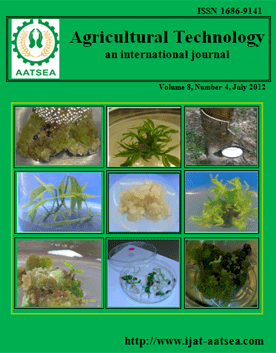ThaiScience
ThaiScience
INTERNATIONAL JOURNAL OF AGRICULTURAL TECHNOLOGY
Volume 16, No. 02, Month MARCH, Year 2020, Pages 485 - 492
Floods increase soil microbial activity in paddy soil: a case study in sakon nakhon province, thailand
Teamkao, P., Lapontun, K., Onkum, P., Chudaeng, D. and Saipluemchit, S.
Abstract Download PDF
The results showed that the different flooding histories caused the effects on some soil properties. Partially flooded areas had the highest soil electrical conductivity at 0.06 mS/cm, but in the range that did not affect plant growth. All studied areas had low levels of organic matter and fields had available phosphorus of less than 4 mg/kg. There was a low level of exchangable potassium under fully flooded areas but a high level under partially flooded and non-flooded areas. The microbial activity revealed the highest soil respiration under fully flooded areas with 0.16 mgCO2/g soil. The highest bacterial and fungal populations, FDA activity, urease, dehydrogenase, and protease activities were found under fully flooded area conditions. However, soil pH, microbial biomass carbon, microbial biomass nitrogen, and acidphosphatase activity were not statistically different. No pesticides in carbamate, organochloride, and organophosphate groups were observed. The amounts of mercury, arsenic, lead, and cadmium were lower than the standard set of Thailand. Flooding did not reduce soil quality in the areas of the study; on the other hand, increased microbial activities were beneficial for plant growth. The effects of flooding on soil properties might differ depending on the conditions in each area.
Keywords
Floods, Soil chemical property, Microbial activity, Soil enzymeINTERNATIONAL JOURNAL OF AGRICULTURAL TECHNOLOGY
Published by : Association of Agricultural Technology in Southeast Asia (AATSEA)
Contributions welcome at : http://www.ijat-aatsea.com
